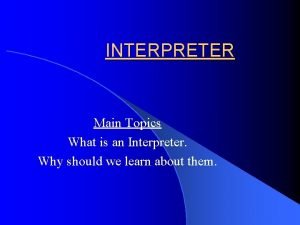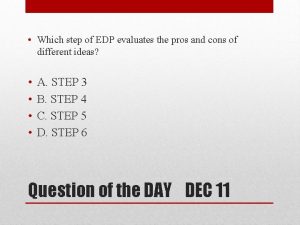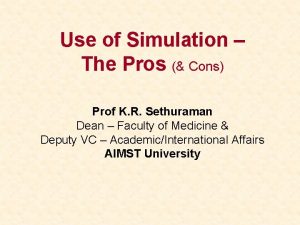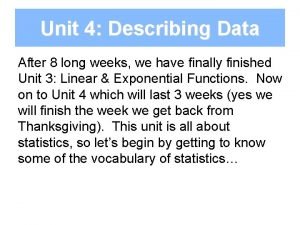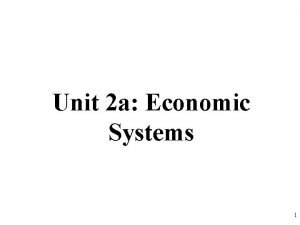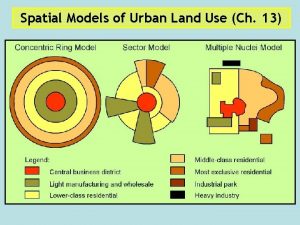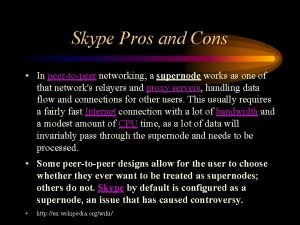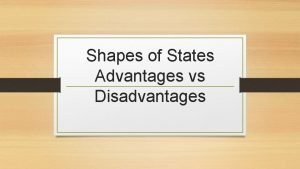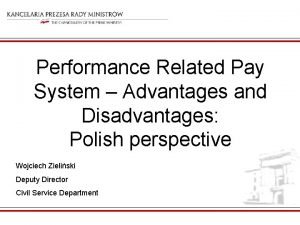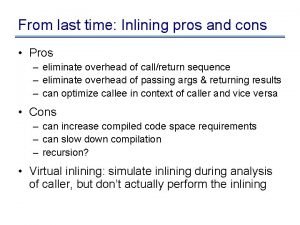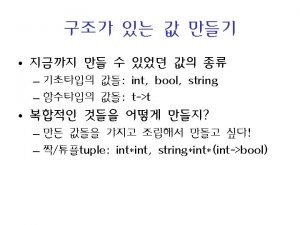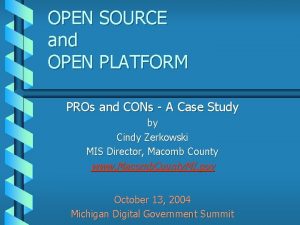Inlining pros and cons discussion Inlining pros and







![Inlining heuristics • Strategy 3: amortized version of 2 [Dean & Chambers 94] – Inlining heuristics • Strategy 3: amortized version of 2 [Dean & Chambers 94] –](https://slidetodoc.com/presentation_image/c922a3a87f5addaab9871665e13f3534/image-8.jpg)












































- Slides: 52

Inlining pros and cons (discussion)

Inlining pros and cons • Pros – eliminate overhead of call/return sequence – eliminate overhead of passing args & returning results – can optimize callee in context of caller and vice versa • Cons – can increase compiled code space requirements – can slow down compilation – recursion? • Virtual inlining: simulate inlining during analysis of caller, but don’t actually perform the inlining

Which calls to inline (discussion) • What affects the decision as to which calls to inline?

Which calls to inline • What affects the decision as to which calls to inline? – size of caller and callee (easy to compute size before inlining, but what about size after inlining? ) – frequency of call (static estimates or dynamic profiles) – call sites where callee benefits most from optimization (not clear how to quantify) – programmer annotations (if so, annotate procedure or call site? Also, should the compiler really listen to the programmer? )

Which calls to inline • The above metrics vary in how easy/hard they are to quantify • Even if one were able to quantify all of them accurately, how does one put them together to make a decision? • Inlining heuristics

Inlining heuristics • Strategy 1: superficial analysis – examine source code of callee to estimate space costs, use this to determine when to inline – doesn’t account for post-inlining optimizations • How can we do better?

Inlining heuristics • Strategy 2: deep analysis – perform inlining – perform post-inlining analysis/optimizations – estimate benefits from opts, and measure code space after opts – undo inlining if costs exceed benefits – better accounts for post-inlining effects – much more expensive in compile-time • How can we do better?
![Inlining heuristics Strategy 3 amortized version of 2 Dean Chambers 94 Inlining heuristics • Strategy 3: amortized version of 2 [Dean & Chambers 94] –](https://slidetodoc.com/presentation_image/c922a3a87f5addaab9871665e13f3534/image-8.jpg)
Inlining heuristics • Strategy 3: amortized version of 2 [Dean & Chambers 94] – perform strategy 2: an inlining “trial” – record cost/benefit trade-offs in persistent database – reuse previous cost/benefit results for “similar” call sites

Inlining heuristics • Strategy 4: use machine learning techniques • For example, use genetic algorithms to evolve heuristics for inlining – fitness is evaluated on how well the heuristics do on a set of benchmarks – cross-populate and mutate heuristics • Can work surprisingly well to derive various heuristics for compilres

Another way to remove procedure calls inf f(. . . ) { if (. . . ) return g(. . . ); . . . return h(i(. . ), j(. . . )); }

Tail call eliminiation • Tail call: last thing before return is a call – callee returns, then caller immediately returns • Can splice out one stack frame creation and destruction by jumping to callee rather than calling – callee reuses caller’s stack frame & return address – callee will return directly to caller’s caller – effect on debugging?

Tail recursion elimination • If last operation is self-recursive call, what does tail call elimination do?

Tail recursion elimination • If last operation is self-recursive call, what does tail call elimination do? • Transforms recursion into loop: tail recursion elimination – common optimization in compilers for functional languages – required by some language specifications, eg Scheme – turns stack space usage from O(n) to O(1)

Addressing costs of procedure calls • Technique 1: try to get rid of calls, using inlining and other techniques • Technique 2: interprocedural analysis, for calls that are left

Interprocedural analysis • Extend intraprocedural analyses to work across calls • Doesn’t increase code size • But, doesn’t eliminate direct runtime costs of call • And it may not be as effective as inlining at cutting the “precision cost” of procedure calls

A simple approach (discussion)

A simple approach • Given call graph and CFGs of procedures, create a single CFG (control flow super-graph) by: – connecting call sites to entry nodes of callees (entries become merges) – connecting return nodes of callees back to calls (returns become splits) • Cons: – speed? – separate compilation? – imprecision due to “unrealizable paths”

Another approach: summaries (discussion)

Code examples for discussion global a; a : = 5; f(. . . ); b : = a + 10; f(p) { *p : = 0; } g() { a : = 5; f(&a); b : = a + 10; } h() { a : = 5; f(&b); b : = a + 10; }

Another approach: summaries • Compute summary info for each procedure • Callee summary: summarizes effect/results of callee procedures for callers – used to implement the flow function for a call node • Caller summaries: summarizes context of all callers for callee procedure – used to start analysis of a procedure

Issues with summaries • Level of “context” sensitivity: – For example, one summary that summarizes the entire procedure for all call sites – Or, one summary for each call site (getting close to the precision of inlining) – Or. . . • Various levels of captured information – as small as a single bit – as large as the whole source code for callee/callers • How does separate compilation work?

Examples of summaries

How to compute summaries • Using Iterative analysis • Keep the current solution in a map from procs to summaries • Keep a worklist of procedures to process • Pick a proc from the worklist, compute its summary using intraprocedural analysis and the current summaries for all other nodes • If summary has changed, add callers/callees to the worklist for callee/caller summaries

How to compute callee summaries let m: map from proc to computed summary let worklist: work list of procs for each proc p in call graph do m(p) : = ? for each proc p do worklist. add(p) while (worklist. empty. not) do let p : = worklist. remove_any; // compute summary using intraproc analysis // and current summaries m let summary : = compute_summary(p, m); if (m(p) summary) m(p) : = summary; for each caller c of p worklist. add(c)

Examples • Let’s see how this works on some examples • We’ll use an analysis for program verification as a running example

Protocol checking Interface usage rules in documentation – Order of operations, data access – Resource management – Incomplete, wordy, not checked Violated rules ) crashes – Failed runtime checks – Unreliable software

FSM protocols • These protocols can often be expressed as FSMs • For example: lock protocol * Error lock unlock Locked Unlocked unlock

FSM protocols • Alphabet of FSM are actions that affect the state of the FSM • Often leave error state implicit • These FSMs can get pretty big for realistic kernel protocols

FSM protocol checking • Goal: make sure that FSM does not enter error state • Lattice:

Lock protocol example main() { g(); f(); lock; unlock; } f() { h(); if (. . . ) { main(); } } g() { lock; } h() { unlock; }

Lock protocol example main() { g(); f(); lock; unlock; } main f() { h(); if (. . . ) { main(); } } f g g() { lock; } h() { unlock; } h


Another lock protocol example main() { g(); f(); lock; unlock; } f() { g(); if (. . . ) { main(); } } g() { if(is. Locked()) { unlock; } else { lock; } }

Another lock protocol example main() { g(); f(); lock; unlock; } main f() { g(); if(is. Locked()) { if (. . . ) { main(); } unlock; } } else { lock; } } f g

Another lock protocol example main() { g(); f(); lock; unlock; } f() { g(); if(is. Locked()) { if (. . . ) { main(); } unlock; } } else { lock; } } main u ; ” ” ” {u, l} {u, e} f ; g ; ” ” l ” ” ” {u, l} ” ” ; u ; ” l ” ” ” {u, l} ” ” ”

What went wrong?

What went wrong? • We merged info from two call sites of g() • Solution: summaries that keep different contexts separate • What is a context?

Approach #1 to context-sensitivity • Keep information for different call sites separate • In this case: context is the call site from which the procedure is called

Example again main() { g(); f(); lock; unlock; } main f() { g(); if(is. Locked()) { if (. . . ) { main(); } unlock; } } else { lock; } } f g

Example again main() { g(); f(); lock; unlock; } main f() { g(); if(is. Locked()) { if (. . . ) { main(); } unlock; } } else { lock; } } f g

How should we change the example? • How should we change our example to break our context sensitivity strategy? main() { g(); f(); lock; unlock; } f() { g(); if (. . . ) { main(); } } g() { if(is. Locked()) { unlock; } else { lock; } }

Answer main() { h(); f(); lock; unlock; } f() { h(); if (. . . ) { main(); } } h() { g() } g() { if(is. Locked()) { unlock; } else { lock; } }

In general • Our first attempt was to make the context be the immediate call site • Previous example shows that we may need 2 levels of the stack – the context for an analysis of function f is: call site L 1 where f was called from AND call site L 2 where f’s caller was called from • Can generalize to k levels – k-length call strings approach of Sharir and Pnueli – Shiver’s k-CFA

Approach #2 to context-sensitivity

Approach #2 to context-sensitivity • Use dataflow information at call site as the context, not the call site itself

Using dataflow info as context main() { g(); f(); lock; unlock; } f() { g(); if(is. Locked()) { if (. . . ) { main(); } unlock; } } else { lock; } } main f g

Transfer functions • Our two pairs of summaries look like functions from input information to output information • We call these transfer functions • Complete transfer functions – contain entries for all possible incoming dataflow information • Partial transfer functions – contain only some entries, and continually refine during analysis

Top-down vs. bottom-up • We’ve always run our interproc analysis top down: from main, down into procs • For data-based context sensitivity, can also run the analysis bottom-up – analyze a proc in all possibly contexts – if domain is distributive, only need to analyze singleton sets

Top-down vs. bottom-up • What are the tradeoffs?

Top-down vs. bottom-up • What are the tradeoffs? – In top-down, only analyze procs in the context that occur during analysis, whereas in bottom-up, may do useless work analyzing proc in a data context never used during analysis – However, top-down requires analyzing a given function at several points in time that are far away from each other. If the entire program can’t fit in RAM, this will lead to unnecessary swapping. On the other hand, can do bottom-up as one pass over the callgraph, one SCC at a time. Once a proc is analyzed, it never needs to be reloaded in memory. – top-down better suited for finite domains

Bottom-up example main() { g(); f(); lock; unlock; } f() { g(); if(is. Locked()) { if (. . . ) { main(); } unlock; } } else { lock; } } main f g

Bottom-up example main() { g(); f(); lock; unlock; } f() { g(); if(is. Locked()) { if (. . . ) { main(); } unlock; } } else { lock; } } main f g ? ? ? ” ” u ! l l ! u ” u ! u l ! e ” ” ” u ! u l ! e u ! {l, e} l ! u ”
 Hub and spoke transportation system
Hub and spoke transportation system What is an interpreter
What is an interpreter Pros and cons of byod and cobo
Pros and cons of byod and cobo Pros and cons of series circuits
Pros and cons of series circuits Pros and cons of artificial nutrition and hydration
Pros and cons of artificial nutrition and hydration Objective and task method pros and cons
Objective and task method pros and cons Disadvantages of consensus
Disadvantages of consensus Advantages of expository writing
Advantages of expository writing Trebuchet vs catapult pros and cons
Trebuchet vs catapult pros and cons Doas.exceed lms
Doas.exceed lms Waldorf education pros and cons
Waldorf education pros and cons Virtual job fairs pros and cons
Virtual job fairs pros and cons Vertical farming pros and cons
Vertical farming pros and cons Pros and cons of kinesthetic learning
Pros and cons of kinesthetic learning Dot plot advantages
Dot plot advantages Command economy pros and cons
Command economy pros and cons Pros and cons of a thrust stage
Pros and cons of a thrust stage Constitutional monarchy pros and cons
Constitutional monarchy pros and cons Pros and cons of trade unions
Pros and cons of trade unions Pros and cons of totalitarianism
Pros and cons of totalitarianism Usa patriot act pros and cons
Usa patriot act pros and cons Is german hard to learn
Is german hard to learn Pros and cons of imperialism
Pros and cons of imperialism Barbara cons
Barbara cons Wind power pros and cons
Wind power pros and cons Pros and cons of organic food
Pros and cons of organic food Advantages of direct method in teaching english
Advantages of direct method in teaching english Philippe van thiel
Philippe van thiel Difference between suggestopedia and desuggestopedia
Difference between suggestopedia and desuggestopedia Tableau pros and cons
Tableau pros and cons Simple2do
Simple2do Solution mining pros and cons
Solution mining pros and cons Pros of capitalism
Pros of capitalism Acid snort
Acid snort Skype pros and cons
Skype pros and cons Siop protocol
Siop protocol Compact state disadvantages
Compact state disadvantages School vouchers pros and cons
School vouchers pros and cons Running start pros and cons
Running start pros and cons Pros and cons of robber barons
Pros and cons of robber barons Gender-neutral housing pros and cons
Gender-neutral housing pros and cons Collaborative filtering pros and cons
Collaborative filtering pros and cons K12
K12 Pros and cons of corporate personhood
Pros and cons of corporate personhood Pros and cons of zoning
Pros and cons of zoning Vet tech pros and cons
Vet tech pros and cons Pros and cons of additional member system
Pros and cons of additional member system Logan stancato
Logan stancato Virulent
Virulent Cultural diversity pros and cons
Cultural diversity pros and cons Pros and cons of pesticides
Pros and cons of pesticides Advantages of performance related pay
Advantages of performance related pay Pros and cons of angel investors
Pros and cons of angel investors

